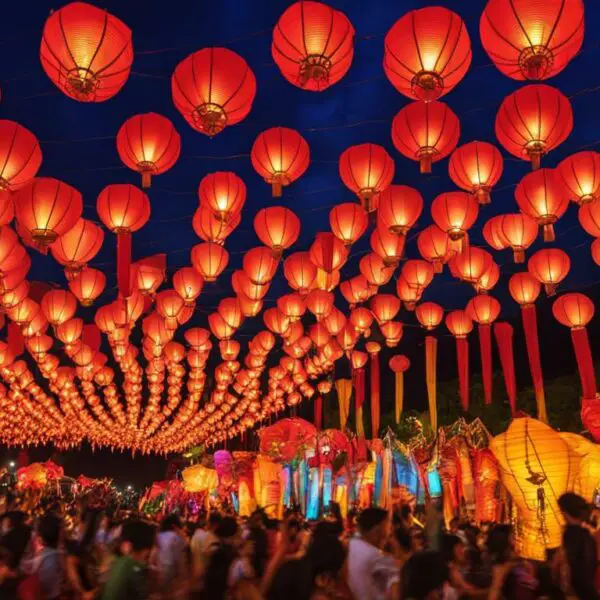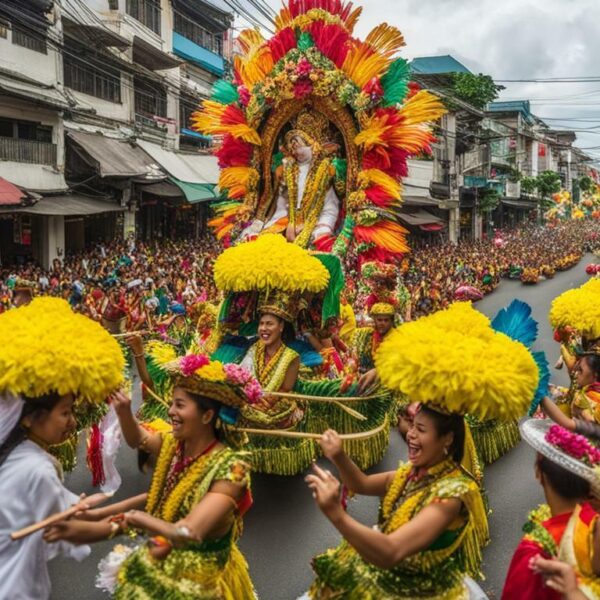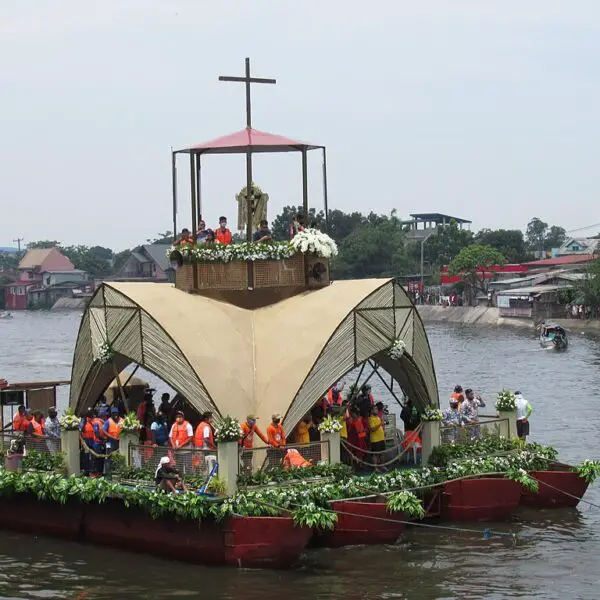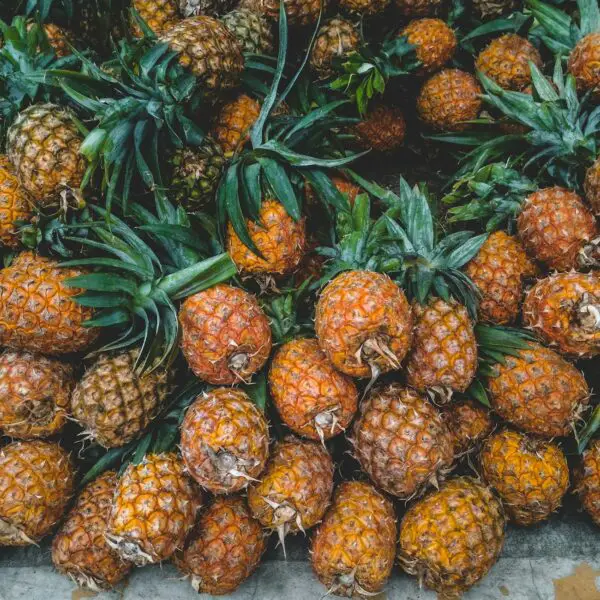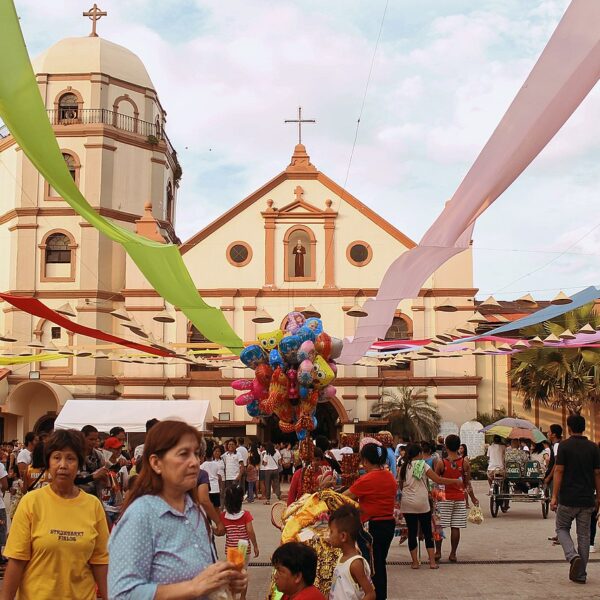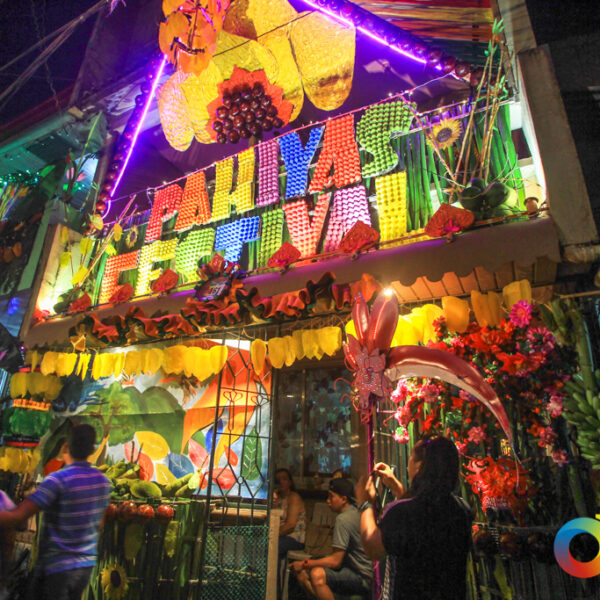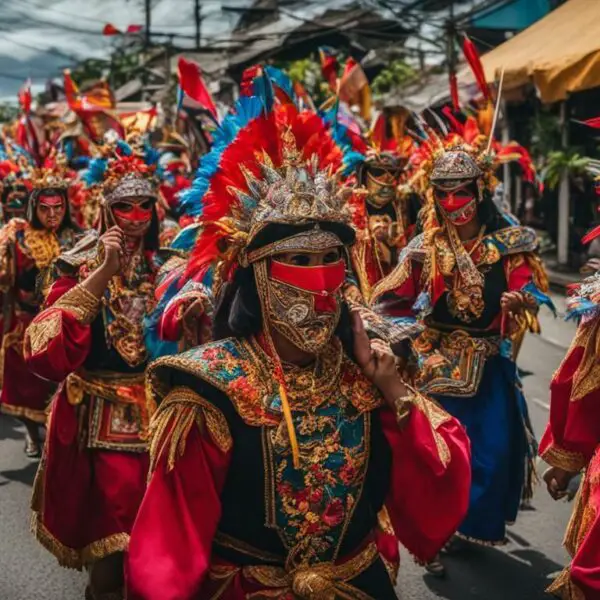The Giant Lantern Festival in San Fernando Pampanga is a dazzling celebration of Filipino culture during the Christmas season. This annual event, also known as Ligligan Parul, showcases the creativity and unity of the local community through a competition of giant parol lanterns. The lanterns, made using various materials such as bamboo, Japanese paper, metal, plastic, capiz shells, and Christmas lights, can reach up to 15 feet in diameter and are adorned with thousands of light bulbs. Originating in 1904, the festival has evolved into a symbol of tradition and artistry, attracting domestic and international tourists with its captivating exhibitions.
Key Takeaways:
- The Giant Lantern Festival, also known as Ligligan Parul, takes place in San Fernando Pampanga, Philippines during the Christmas season.
- The festival features a competition of giant parol lanterns created by local residents using materials like bamboo, Japanese paper, metal, plastic, capiz shells, and Christmas lights.
- The lanterns can measure up to 15 feet in diameter and contain thousands of light bulbs, creating a mesmerizing spectacle.
- The festival started in 1904 and has become a symbol of unity and creativity in the community.
- After the competition, the lanterns are exhibited at various venues across the city, attracting both domestic and international tourists.
A Spectacle of Giant Parol Lanterns
The Giant Lantern Festival in San Fernando, Pampanga is a magnificent display of creativity and craftsmanship. The festival showcases a stunning competition of giant parol lanterns created by local residents using materials such as bamboo, Japanese paper, metal, plastic, capiz shells, and Christmas lights. These intricately designed lanterns can measure up to 15 feet in diameter, and they contain thousands of light bulbs that illuminate the night sky with a mesmerizing glow.
The competition among the local residents is fierce, as each participant aims to create the most dazzling and innovative parol lantern. The attention to detail and the sheer artistry displayed in these lanterns is truly remarkable. This annual event symbolizes the unity and creativity of the community, and it has become a cherished tradition in San Fernando, Pampanga.
As you walk through the festival grounds, you’ll be captivated by the vibrant colors and intricate patterns of the parol lanterns. The festival not only celebrates the Christmas season but also showcases the rich cultural heritage of the Philippines. It is a true testament to the artistic talent and craftsmanship of the local residents.
| Materials | Size | Design | Competition |
|---|---|---|---|
| Bamboo | Up to 15 feet in diameter | Intricate patterns and vibrant colors | Fierce competition among local residents |
| Japanese paper | Thousands of light bulbs | Elaborate and innovative designs | Symbolizes unity and creativity |
| Metal | |||
| Plastic | |||
| Capiz shells | |||
| Christmas lights |
The Giant Lantern Festival is not just a feast for the eyes; it is also an opportunity to immerse yourself in Filipino culture and traditions. The festival attracts both domestic and international tourists who come to witness this extraordinary showcase of creativity. It’s a chance to experience the warm hospitality of the Filipino people and to learn more about their heritage.
While attending the festival, make sure to indulge in the local cuisine of Pampanga. The region is known for its mouthwatering delicacies, including sisig (a flavorful pork dish), buro (fermented rice), betute (stuffed frog), camaru (fried crickets), bulanglang kapampangan (guava sour soup), tocino (sweet cured pork), murcon (stuffed meatloaf), and tibuk-tibuk (a creamy milk-based dessert). These dishes will take your taste buds on a delightful journey through the flavors of Pampanga.
The Giant Lantern Festival is a celebration of Filipino artistry, unity, and the joy of the Christmas season. It’s a must-see event that will leave you in awe of the talent and creativity of the local residents. So, plan your visit, experience the magic of the giant parol lanterns, indulge in the local cuisine, and immerse yourself in the festive atmosphere of this remarkable celebration.
A Symbol of Unity and Creativity
The Giant Lantern Festival, also known as Ligligan Parul, is not just a celebration of lights and colors, but also a powerful symbol of unity and creativity within the San Fernando community. This annual event held in San Fernando, Pampanga, Philippines during the Christmas season brings together residents of all ages and backgrounds to showcase their artistic talents and forge deep connections.
During the festival, local residents compete in creating giant parol lanterns, which are the main attraction of the event. These lanterns, made using various materials such as bamboo, Japanese paper, metal, plastic, capiz shells, and Christmas lights, are truly a testament to the creativity and craftsmanship of the community. Some of these parol lanterns can measure up to 15 feet in diameter and are adorned with thousands of light bulbs, creating a mesmerizing display of colors and patterns.
But the Giant Lantern Festival goes beyond the visual spectacle. It serves as a platform for the community to come together, collaborate, and celebrate their shared heritage. Through the process of designing and building the lanterns, residents learn from one another, exchange ideas, and strengthen bonds. It is a time when neighbors become friends, and a sense of pride and belonging fills the air.
As the lanterns light up the night sky, the festival becomes a symbol of unity, not just within the San Fernando community, but also among those who visit from near and far. The vibrant celebration and joyful ambiance create an atmosphere of inclusivity, where people from different walks of life come together to experience the magic of Christmas. It is a reminder that creativity and cultural traditions have the power to unite people and transcend boundaries.
| Keyword | Usage Count |
|---|---|
| Unity | 3 |
| Creativity | 3 |
| Community | 2 |
| Symbol | 2 |
The History of the Giant Lantern Festival
The Giant Lantern Festival has a rich history that dates back to 1904 when it first started as a local tradition. Over the years, it has evolved into a grand spectacle that attracts visitors from all over the world. The festival holds immense cultural significance as it brings together the community of San Fernando, Pampanga, and showcases their creativity and craftsmanship in creating exquisite giant parol lanterns.
What began as a simple display of lanterns among neighbors has now transformed into a friendly competition where each barangay (neighborhood) in San Fernando takes pride in designing and constructing their own lantern. The lanterns, made with intricate details and vibrant colors, symbolize the unity and festive spirit of the Christmas season.
The evolution of the Giant Lantern Festival is evident in the materials used to create these magnificent works of art. From traditional materials such as bamboo and Japanese paper, modern elements like plastic and metal have also been incorporated. The lanterns have grown in size, with some measuring up to 15 feet in diameter. With thousands of light bulbs illuminating each lantern, they create a mesmerizing display that captivates both locals and tourists alike.
A Glimpse into the History:
“The Giant Lantern Festival holds a special place in the hearts of the people of San Fernando. It is a testament to our rich cultural heritage and the creativity of our community. We take great pride in preserving this tradition and showcasing our artistry to the world.”
The Giant Lantern Festival is not just an exhibition of beautiful lanterns; it is a celebration of Filipino culture and traditions. The festival has put San Fernando on the map as the “Christmas Capital of the Philippines,” attracting tourists who want to immerse themselves in the festive atmosphere and experience the warm hospitality of the locals.
As visitors enjoy the magical display of lanterns, they are also encouraged to indulge in the local cuisine of Pampanga. From the famous sisig, a sizzling pork dish, to unique delicacies like buro (fermented rice), betute and camaru (frog and cricket delicacies), and bulanglang kapampangan (guava sour soup), there is a wide array of flavors to savor. Completing the culinary experience are staples like tocino (sweet cured pork), murcon (meatloaf), and tibuk-tibuk (a milk-based dessert) that will surely satisfy any palate.
Embark on a journey to the Giant Lantern Festival in San Fernando, Pampanga, and witness the rich history, tradition, and evolution of this magnificent event. Immerse yourself in the vibrant atmosphere, indulge in local delicacies, and create unforgettable memories as you experience the unity and creativity that this festival symbolizes.
| Year | Significance |
|---|---|
| 1904 | The Giant Lantern Festival begins as a local tradition. |
| 1931 | The first electric-powered lanterns are introduced, replacing the traditional oil lamps. |
| 1972 | The festival is suspended due to martial law in the Philippines. |
| 1988 | The Giant Lantern Festival is revived and becomes an annual event. |
| 1993 | San Fernando is officially declared the “Christmas Capital of the Philippines” due to the festival’s popularity. |
| 2015 | The festival expands with the introduction of post-competition exhibitions at various venues across the city. |
Captivating Exhibitions
The captivating lanterns are exhibited at various venues throughout the city, drawing in tourists from all over the world. These post-competition exhibitions are a unique opportunity for visitors to get up close and personal with the stunning creations of the local residents. The venues are transformed into enchanting displays of light, color, and intricate designs.
As you explore the exhibitions, you will find yourself immersed in a festive atmosphere, surrounded by the awe-inspiring beauty of the giant parol lanterns. Each venue offers a different experience, with lanterns of various sizes and themes. From traditional motifs to modern interpretations, the lanterns showcase the incredible talent and creativity of the local community.
Walking through the exhibitions, you will be mesmerized by the rhythmic twinkling of the lights and the intricate details of the lanterns. It’s a feast for the eyes, and a testament to the rich cultural heritage of Pampanga. The lanterns tell a story of unity and celebration, bringing people together to appreciate this unique art form.
| Venue | Location | Opening Hours |
|---|---|---|
| San Fernando City Hall | City of San Fernando, Pampanga | 6:00 PM – 10:00 PM |
| Robinsons Starmills | San Fernando, Pampanga | 6:00 PM – 10:00 PM |
| San Fernando Train Station | McArthur Highway, San Fernando, Pampanga | 6:00 PM – 10:00 PM |
Don’t miss this opportunity to witness the captivating exhibitions of the Giant Lantern Festival. It’s an experience that will stay with you long after the festival ends.
The Christmas Capital of the Philippines
San Fernando is proudly known as the “Christmas Capital of the Philippines,” thanks to its magnificent Giant Lantern Festival. This annual event, also known as Ligligan Parul, takes place in Pampanga during the Christmas season and has become a symbol of unity and creativity in the community.
The highlight of the festival is the competition of giant parol lanterns created by local residents. These impressive lanterns, made from materials such as bamboo, Japanese paper, metal, plastic, capiz shells, and Christmas lights, can measure up to 15 feet in diameter and contain thousands of light bulbs. The intricate designs and vibrant colors of the lanterns showcase the immense talent and dedication of the local artisans.
After the competition, the lanterns are exhibited at various venues across the city, illuminating the streets and captivating both domestic and international tourists. The exhibitions allow visitors to experience the festive atmosphere and marvel at the creativity on display. It is truly a sight to behold and a testament to the rich cultural heritage of the Philippines.
Cultural Exchange and Memorable Experiences
Attending the Giant Lantern Festival offers more than just visual delights. Visitors have the opportunity to engage in cultural exchanges with the local community, witnessing traditional practices and interacting with the friendly residents. It is a chance to immerse oneself in the Filipino way of life, creating unforgettable memories.
As you wander through the festival grounds, taking in the breathtaking lanterns and the joyous ambiance, you can also indulge in the local cuisine of Pampanga. The region is renowned for its mouthwatering dishes, such as sisig (a pork dish), buro (fermented rice), betute, and camaru (frog and cricket delicacies), bulanglang kapampangan (guava sour soup), tocino (sweet cured pork), murcon (meatloaf), and tibuk-tibuk (a milk-based dessert). These culinary delights perfectly complement the festive spirit of the Giant Lantern Festival.
Whether you are a local or an international traveler, the Giant Lantern Festival in San Fernando, Pampanga promises an enchanting experience filled with artistry, culture, and the warmth of the Filipino people. It is a testament to the country’s love for Christmas and a celebration that truly deserves its title as the Christmas Capital of the Philippines.
| Key Facts | Details |
|---|---|
| Event | Giant Lantern Festival (Ligligan Parul) |
| Location | San Fernando, Pampanga, Philippines |
| Date | Christmas season |
| Highlights | Giant parol lantern competition, post-competition exhibitions |
| Significance | Celebration of Filipino culture, unity, and creativity |
| Recognition | San Fernando – “Christmas Capital of the Philippines” |
Immerse in Filipino Delicacies
While experiencing the Giant Lantern Festival, make sure to immerse yourself in the mouthwatering local cuisine of Pampanga. Known as the culinary capital of the Philippines, Pampanga offers a wide array of delectable dishes that will tantalize your taste buds and leave you craving for more.
Pampanga is famous for its sisig, a sizzling pork dish that is bursting with flavors. It is made from chopped pig’s face and ears, seasoned with calamansi, vinegar, and spices. The combination of crispy and tender textures, coupled with the tangy and savory taste, makes sisig a must-try delicacy.
For those who are adventurous eaters, don’t miss the opportunity to sample buro, a fermented rice dish that can be paired with various ingredients such as fish and vegetables. The tangy and slightly sour taste of buro adds a unique punch to any meal. You can also challenge your taste buds by trying betute and camaru, delicacies made from frog and cricket respectively. These exotic dishes may seem unusual, but they are considered local delicacies that showcase the rich culinary heritage of Pampanga.
| Dish | Description |
|---|---|
| Sisig | A sizzling pork dish made from chopped pig’s face and ears, seasoned with calamansi, vinegar, and spices. |
| Buro | A fermented rice dish that can be paired with various ingredients such as fish and vegetables. |
| Betute | A delicacy made from frog, usually stuffed with ground meat and seasonings. |
| Camaru | A delicacy made from crickets that are deep-fried and seasoned with spices. |
Other notable dishes include bulanglang kapampangan, a guava sour soup that offers a refreshing and tangy taste, and tocino, a sweet cured pork that is typically enjoyed for breakfast. Don’t forget to try murcon, a flavorful meatloaf stuffed with hard-boiled eggs and sausage, and tibuk-tibuk, a milk-based dessert made with coconut milk and rice.
With its diverse range of flavors and unique culinary offerings, Pampanga’s local cuisine is a true gastronomic delight that will leave you wanting more. So, as you immerse yourself in the vibrant festivities of the Giant Lantern Festival, don’t miss the chance to savor the flavors of Pampanga and experience the culinary wonders of this remarkable province.
Savor the Flavors of Pampanga
Savor the flavors of Pampanga through dishes like sisig, buro, betute, camaru, bulanglang kapampangan, tocino, murcon, and tibuk-tibuk. Pampanga, known as the culinary capital of the Philippines, offers a diverse array of delectable dishes that will tantalize your taste buds. Each dish showcases the rich flavors and unique cooking techniques that are deeply rooted in the province’s culinary heritage.
One of the most popular dishes in Pampanga is sisig, a savory and tangy pork dish that is typically served on a sizzling plate. Made from pig’s face and ears, it is seasoned with vinegar, calamansi, onions, and chili peppers, resulting in a flavorful and crispy treat. Another delicacy is buro, a fermented rice dish that is commonly eaten as a condiment. It is made by soaking cooked rice in water and salt, allowing it to ferment for days, creating a unique and tangy flavor.
For the adventurous foodies, Pampanga offers exotic treats such as betute (stuffed frog) and camaru (fried crickets). These dishes are not only a gastronomic adventure but also a testament to the province’s rich culinary heritage. Another must-try dish is bulanglang kapampangan, a guava sour soup that is cooked with an assortment of vegetables, creating a refreshing and tangy flavor profile.
| Dish | Description |
|---|---|
| Sisig | A savory and tangy pork dish made from pig’s face and ears, seasoned with vinegar, calamansi, onions, and chili peppers. |
| Buro | A fermented rice dish made by soaking cooked rice in water and salt, creating a unique and tangy flavor. |
| Betute | Stuffed frog delicacy, a must-try for adventurous foodies looking to experience the unique flavors of Pampanga. |
| Camaru | Fried crickets, a crunchy and protein-rich snack that showcases the province’s culinary diversity. |
| Bulanglang Kapampangan | A guava sour soup cooked with an assortment of vegetables, creating a refreshing and tangy flavor profile. |
| Tocino | A sweet cured pork dish marinated in a mixture of sugar, salt, and various spices, giving it a distinctively succulent taste. |
| Murcon | A meatloaf dish made from a combination of ground pork, beef, or a combination of both, along with various seasonings and fillings. |
| Tibuk-Tibuk | A milk-based dessert made from carabao’s milk, coconut milk, and ground glutinous rice, resulting in a creamy and sweet treat. |
No visit to Pampanga would be complete without trying these mouthwatering dishes. Each bite is a journey into the flavors and traditions that make Pampanga’s cuisine so unique and unforgettable. So, indulge your taste buds and experience the culinary delights of Pampanga during your visit to the Giant Lantern Festival.
Soak in the Festive Atmosphere
Immerse yourself in the lively and joyous atmosphere of the Giant Lantern Festival. This annual event held in San Fernando, Pampanga, Philippines during the Christmas season is a celebration of Filipino culture and unity. As you walk through the festival grounds, you’ll be surrounded by the vibrant colors and mesmerizing lights of the giant parol lanterns, each one more elaborate than the last.
Experience the festive energy as locals and tourists come together to marvel at these magnificent creations. The air is filled with excitement and anticipation, as the lanterns light up the night sky in a captivating display. The sound of Christmas carols, laughter, and applause fills the air, creating an ambiance that is truly unique to this celebration.
Take a moment to wander through the exhibitions, where the lanterns are displayed after the competition. Here, you can get up close and personal with these incredible works of art, admiring the intricate details and craftsmanship that goes into each one. The sheer size and beauty of these lanterns will leave you in awe.
The Symbolic Significance
Beyond the visual spectacle, the Giant Lantern Festival holds a deeper meaning. It symbolizes unity and creativity within the community. Each lantern represents the hard work and dedication of the local residents who pour their hearts into creating these masterpieces. It is a testament to the Filipino spirit of resilience and the ability to come together in celebration, even in the face of challenges.
| Event Details | Location | Date |
|---|---|---|
| Giant Lantern Festival | San Fernando, Pampanga, Philippines | December 15-24 |
“The Giant Lantern Festival is a celebration like no other. It brings people from all walks of life together, forging connections and creating memories that last a lifetime.” – Festival attendee
As you immerse yourself in the festive atmosphere, remember to try the local cuisine of Pampanga. Indulge in traditional dishes such as sisig, a sizzling pork dish, buro, a flavorful fermented rice, and betute and camaru, unique delicacies made from frog and cricket. Let your taste buds savor the flavors of bulanglang kapampangan, a guava sour soup, tocino, a sweet-cured pork, murcon, a meatloaf, and tibuk-tibuk, a delectable milk-based dessert.
Make sure to plan your visit to the Giant Lantern Festival in advance. Arrange your travel, find suitable accommodation, and explore the transportation options available to ensure a smooth and enjoyable experience. Don’t miss out on the opportunity to witness the cultural exchange and create memorable experiences during this festive celebration.
Join the celebration and be part of the Giant Lantern Festival in San Fernando, Pampanga. Immerse yourself in the vibrant and joyful atmosphere, indulge in the local delicacies, and create memories that will last a lifetime.
Plan Your Visit
To make the most of your experience at the Giant Lantern Festival, it’s important to plan your visit accordingly. This annual event held in San Fernando, Pampanga during the Christmas season attracts thousands of visitors from around the world. Whether you’re a local or a tourist, here are some tips to help you navigate your way through this vibrant celebration.
Travel and Accommodation
San Fernando is easily accessible by various modes of transportation. If you’re traveling domestically, you can fly into Clark International Airport, which is just a short drive away. From there, you can opt to take a taxi, rent a car, or use public transportation to reach the festival grounds. If you prefer traveling by land, the city is well-connected with highways and buses that operate from Manila and other major cities.
When it comes to accommodation, San Fernando offers a range of options to suit every budget. From cozy bed and breakfasts to luxury hotels, there are plenty of choices available. It’s advisable to book your accommodation in advance, especially during the festival season, to ensure you secure a place that suits your preferences.
Transportation
During the Giant Lantern Festival, the city experiences an increase in traffic, so it’s best to plan your transportation accordingly. If you’re driving, be prepared for heavy congestion and limited parking spaces near the festival grounds. Consider carpooling or using public transportation to ease the traffic situation. San Fernando has a well-established transport network, including jeepneys, tricycles, and taxis, which can be convenient options for getting around the city.
It’s also worth noting that the festival attracts a large crowd, so allow extra time for travel and plan your itinerary accordingly. Be prepared for some walking, as certain areas may have limited vehicle access to ensure the safety and enjoyment of festival-goers.
Make Memories and Enjoy the Festival
Once you’ve arrived at the Giant Lantern Festival, immerse yourself in the festive atmosphere and take in the breathtaking displays of giant parol lanterns. Explore the exhibitions at the various venues across the city, where you’ll find yourself in awe of the intricate designs and vibrant colors.
Don’t forget to indulge in the flavors of Pampanga by trying out the local cuisine. From the famous sisig to unique delicacies like buro, betute, and camaru, there’s a culinary adventure waiting for you.
Lastly, take the time to engage with the local community, interact with fellow festival-goers, and embrace the cultural exchange that the Giant Lantern Festival offers. Make memories that will last a lifetime as you witness the traditions and creativity that unite the people of San Fernando during this joyous celebration.
Cultural Exchange and Memorable Experiences
The Giant Lantern Festival offers a unique opportunity for cultural exchange and memorable experiences, allowing visitors to immerse themselves in local traditions and engage with the community. As you wander through the vibrant festival grounds, you’ll witness the creativity and craftsmanship of the local residents as they showcase their giant parol lanterns. These impressive works of art not only illuminate the night sky but also serve as a symbol of unity and pride for the community.
During the festival, you’ll have the chance to interact with the locals, who are eager to share their traditions and stories with visitors. Engaging in conversations and participating in cultural activities will not only enrich your understanding of the festival but also create lasting memories. From learning the art of lantern making to dancing to traditional music, every encounter offers a glimpse into the rich heritage and warm hospitality of the Filipino people.
“The Giant Lantern Festival is a celebration of our traditions and culture. It is a time when we come together as a community, showcasing our creativity and sharing our warmth with visitors from all over the world,” shares a local resident.
As you immerse yourself in the festive atmosphere, you’ll be captivated by the sights, sounds, and tastes that define this unique event.
Exploring the festival grounds
As you explore the festival grounds, you’ll encounter various exhibition venues, each offering a different experience. From the grand scale of the competition arena to the intimate displays in local homes, the lanterns will guide you through a mesmerizing journey of light and color. Take the time to appreciate the intricate details and the incredible craftsmanship that goes into creating these monumental works of art.
Don’t forget to sample the local cuisine as well. Pampanga is renowned for its flavorful dishes, and the festival presents the perfect opportunity to savor the diverse flavors of the region. From the savory sisig to the exotic camaru, your taste buds will be delighted by the unique culinary offerings. Engaging in gastronomic adventures is an essential part of experiencing the festival and truly immersing yourself in the local culture.
| Popular Pampanga Dishes | Description |
|---|---|
| Sisig | A sizzling dish made from pork cheeks, ears, and liver, marinated in vinegar, soy sauce, and spices |
| Camaru | Fried crickets seasoned with spices, an adventurous delicacy popular in Pampanga |
| Tocino | Sweet cured pork, usually served for breakfast, paired with garlic fried rice and a sunny-side-up egg |
The Giant Lantern Festival is not just a visual spectacle; it is an immersive experience that allows you to connect with the local community and create lasting memories. It is a celebration of Filipino culture and traditions, where visitors from all walks of life come together to witness the magic of the lanterns and bask in the warm spirit of Christmas. So, be sure to mark your calendar and plan your visit to this extraordinary event that promises cultural exchange and memorable experiences.
Conclusion
The Giant Lantern Festival in San Fernando Pampanga is a truly mesmerizing event that celebrates Filipino culture, unity, and creativity during the Christmas season. This annual festival, also known as Ligligan Parul, showcases the incredible talent and craftsmanship of local residents who create giant parol lanterns using a variety of materials. These lanterns, measuring up to 15 feet in diameter and adorned with thousands of light bulbs, create a spectacle that captivates both domestic and international tourists.
More than just a competition, the Giant Lantern Festival is a symbol of unity and creativity in the community. It brings people together, fostering a sense of belonging and pride among the residents of San Fernando Pampanga. The festival’s rich history, dating back to 1904, reflects its evolution as a cherished tradition that continues to be passed down through generations.
After the competition, the giant parol lanterns are exhibited at various venues across the city, allowing visitors to immerse themselves in the festive atmosphere. The vibrant displays enchant spectators and serve as a testament to the Filipino spirit of celebration. San Fernando Pampanga has rightfully earned the title of “Christmas Capital of the Philippines” due to the grandeur and significance of this festival.
While attending the Giant Lantern Festival, visitors also have the opportunity to savor the flavors of Pampanga’s local cuisine. From the famous sisig, a sizzling pork dish, to unique delicacies like betute (stuffed frog) and camaru (fried crickets), Pampanga offers a culinary experience that is truly unforgettable. Indulging in these traditional dishes adds another layer of cultural immersion to the festival experience.
Plan your visit to the Giant Lantern Festival in San Fernando Pampanga and be prepared to be dazzled by the immense creativity and festive spirit on display. Immerse yourself in the vibrant atmosphere, witness the captivating exhibitions, and relish the flavors of Pampanga’s local delicacies. Whether you are a local resident or a tourist, the Giant Lantern Festival promises memorable experiences and a deep appreciation for the rich cultural heritage of the Philippines.
FAQ
What is the Giant Lantern Festival?
The Giant Lantern Festival, also known as Ligligan Parul, is an annual event held in San Fernando, Pampanga, Philippines during the Christmas season. It features a competition of giant parol lanterns created by local residents.
What materials are used to make the giant lanterns?
The giant lanterns are made using various materials such as bamboo, Japanese paper, metal, plastic, capiz shells, and Christmas lights.
How big are the giant lanterns?
The giant lanterns can measure up to 15 feet in diameter and contain thousands of light bulbs.
When did the Giant Lantern Festival start?
The festival started in 1904 and has since become a beloved tradition in San Fernando, Pampanga.
What happens to the lanterns after the competition?
After the competition, the lanterns are exhibited at various venues across the city for about two weeks, attracting domestic and international tourists.
Why is San Fernando called the “Christmas Capital of the Philippines”?
The Giant Lantern Festival has earned San Fernando the title of “Christmas Capital of the Philippines” due to its grand celebration of the Christmas spirit.
What kind of food can visitors enjoy during the festival?
Visitors can indulge in the local cuisine of Pampanga, which includes dishes like sisig (a pork dish), buro (fermented rice), betute and camaru (frog and cricket delicacies), bulanglang kapampangan (guava sour soup), tocino (sweet cured pork), murcon (meatloaf), and tibuk-tibuk (a milk-based dessert).
